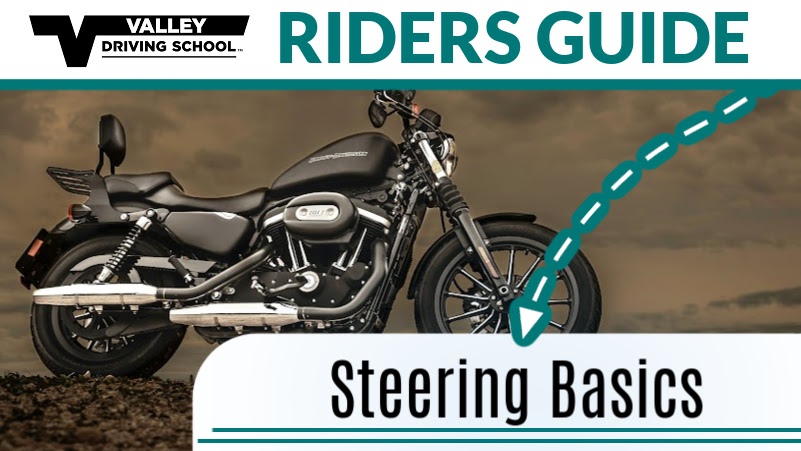Motorcycle riding offers a thrilling and deeply rewarding experience, blending exhilaration with the need for careful skill and knowledge to ensure safety on the road. Central to mastering this dynamic activity is the art of steering—a fundamental aspect that directly influences control and maneuverability.

We’re delving into some essential tips for understanding motorcycle steering basics, and how to improve riding techniques.
Motorcycle Steering Mechanics & Techniques
Grasping the fundamental mechanics of motorcycle steering will help any rider turn theoretical information into practical application! Before hitting the road, consider practicing steering techniques in a safe, controlled environment like an empty parking lot or a designated practice area. These spaces are ideal for riders to familiarize themselves with countersteering, body positioning, and proper braking at low speeds and as confidence is gained, riders can gradually incorporate techniques into on-road.

While a typical car benefits from four wheels that ensure stability, a motorcycle operates with just two and demands a heightened vigilance from the rider to uphold balance and command during every ride. At the heart of steering control are the handlebars, serving as the primary interface for directional adjustments and by angling the handlebars to the left or right, the rider initiates a corresponding turn of the front wheel, dictating the motorcycle's path with precision and responsiveness. This direct connection between the rider and motorcycle underscores the skill and attentiveness required to navigate safely and confidently on two wheels.
Steering a motorcycle is not just about turning the handlebars; it's about utilizing your entire body to guide the motorcycle with finesse. Body position plays a role in effective motorcycle steering; leaning slightly in the direction of the turn can significantly enhance control and stability. Countersteering makes the turn smoother and easier, although it may seem like the opposite of what you should do! If you want to turn left, you gently push on the left handlebar. This makes the bike lean to the left and that will take you into a left turn, and to return to an upright position, push on the right handlebar. This technique highlights the relationship between rider input and motorcycle response, underscoring the importance of skill and technique in achieving fluid and controlled maneuvers on two wheels.

Another technique that impacts motorcycle steering is to “look where you want to go”, and riders may have already heard of this phenomenon, as it is also well-recognized among drivers. Target fixation, which is fixating on obstacles that you need to avoid, can be a frequent error among novice riders. When riders become fixated on an obstacle, whether it's a pothole, debris, or another vehicle, their subconscious may lead them to inadvertently steer towards it instead of safely navigating away. To counteract this tendency riders should maintain a clear visual focus on the desired route ahead and keep their gaze fixed on where they want to go, whether it's the smooth curve of the road ahead or the open space beyond an obstacle, and the motorcycle will be naturally guided in that direction. This proactive visual strategy enhances the ability to avoid hazards effectively and fosters smoother, more confident riding experiences by reinforcing a proactive approach to navigation and control on the road.
Speed Awareness & Braking Techniques
Riding at high speeds amplifies the challenge of steering and maintaining control of a motorcycle. Steering and control challenges are increased on wet or slippery roads as well, where the risk of losing traction is heightened, so reduce speed significantly and approach turns with extra caution to navigate safely in such conditions. This will improve the ability to react promptly to unexpected situations and maintain stability, ensuring a safer ride overall.

Another aspect of motorcycle steering is using the brakes correctly. The best time to apply the brakes is when you are upright and moving in a straight line, and you should plan your riding behaviours to avoid braking in a curve. If braking in a curve is unavoidable, brake cautiously and smoothly to avoid losing traction. When applying the brakes, gently squeeze the rear brake pedal, which transfers weight to the front wheel and improves stability. Gradually add pressure to the front brake lever, which provides a significant portion of the stopping power. Avoid grabbing the front brake lever too abruptly, as this can lock the front wheel and cause skidding.
The throttle is the key to standing the bike back up at the end of the turn as you straighten out. Known as rolling, easing on the throttle, or rolling the throttle, during the turn allows the bike to settle into its pathway and remain balanced so you can concentrate on keeping your eyes on your pathway during the turn. Using your brake during the turn to slow down, or using too little throttle in the turn could cause you to become unbalanced and disconnected, meaning it’ll require a lot more intervention from you as a rider. Your speed should always be adjusted appropriately before entering the turn. At the end of the corner, ease on the throttle slowly to help stand the bike up from its natural cornering lean at the exit. You’ll emerge upright, in total balance, and looking in the direction of your intended travel.
-
Mastering motorcycle steering is a journey of continuous learning and practice. Understanding the fundamentals, employing effective techniques, and prioritizing safety will allow riders to increase their confidence and capability. If you’re looking to get some direction from the professionals or start your riding career, enrolling in our training program is an excellent way to further develop skills and gain valuable knowledge from experienced instructors. Happy riding!

